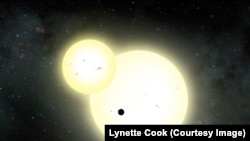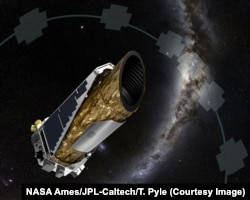Two suns setting on the horizon conjures up images of Star Wars, and Luke Skywalker on his home planet, in a galaxy far, far away. And since the launch of NASA's Kepler mission in 2009, scientists have discovered almost a dozen planets orbiting two stars right here in our own galaxy.
But their recent discovery of a very large planet is of particular interest.
Different from the rest
Researchers at NASA’s Goddard Space Flight Center and San Diego State University have discovered the first Jupiter-sized planet orbiting in the habitable zone of a binary system. It is 3,700 light-years away and about the same age as Earth. “This one is different from the others,” William Welsh, co-investigator of the project tells VOA. It’s called Kepler-1647b and it's "telling us there’s a whole bunch of planets like this out there that we haven’t seen before.”
Previous research has identified planets the size of Saturn and Neptune orbiting very close to double stars. But there is a noticeable lack of Jupiter-sized planets in close orbits. Richard Nelson, Professor of Astronomy and Mathematics at Queen Mary University of London, and a colleague did some research that tells us why. Giant planets whose orbits are too close to the central stars “would literally get kicked out of the system,” Nelson explains. His simulations showed that if Jupiter-sized planets were going to survive, they would need to be farther away from the stars. So Kepler-1647b is exactly where it should be, according to his calculations.
But astronomers weren’t seeing them before now. Fifty percent of stars like our Sun come in pairs and those solar systems are expected to have planets of all sizes, just like single stars. The Jupiter-sized planets are really hard to find due to their long orbits, explains Welsh. “When it takes three years to get one transit, you’re not going to get many of them.” The fact that the planet is orbiting two stars instead of one doesn't make the job any easier.
The Kepler spacecraft detects planets when they pass between us and their star. With one star, it's simple enough: you wait until the light from the star dims due to a planet passing in front of it and you're done.
But two stars locked in orbit move like two ice skaters holding hands and spinning. Their light output changes as they pass in front of each another. Now throw in a third, much tinier skater, like a mouse, sliding around the first two. There will be times when the mouse seems to move in the same direction as our skaters, and times when it looks like it’s moving in the opposite direction. In Kepler-1647b's case, when the planet moves between the stars and us, it doesn't produce one single dip but many different ones, long and short, deep and shallow, depending on its position relative to the stars. Astronomers need lots of measurements at different points in the three year orbit to verify that the dips match what is expected when a Jupiter-sized planet orbits two stars.
Warm Jupiter
Kepler-1647b orbits its two stars at a slightly farther distance than Jupiter circles the Sun. Jupiter is hundreds of millions of kilometers from the habitable zone in our solar system. But having two stars similar to the Sun pushes the habitable zone outwards, enveloping Kepler-1647b in its warmth.
Unfortunately, Kepler-1647b is a gas giant, so extraterrestrial beings probably wouldn’t be able to survive on the planet, much less enjoy that double sunset. But any moons orbiting the planet could be suitable for life. Current technology cannot detect moons around planets outside the solar system but astronomers are working on it, according to Welsh.
And that conjures up even more Star Wars imagery, in this case of Endor, with its Ewok-populated moon. Something like it, scientists predict, may in fact exist in our own galaxy.






